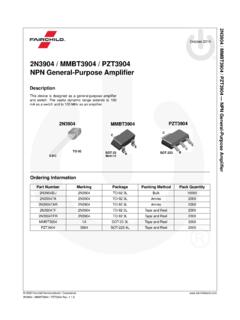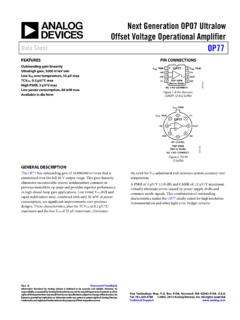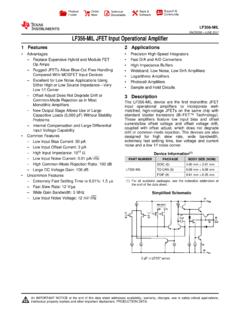Transcription of 2 GHz to 28 GHz, GaAs pHEMT MMIC Low Noise Amplifier …
1 2 GHz to 28 GHz, GaAs pHEMT MMIC Low Noise Amplifier Data Sheet HMC7950 Rev. A Document Feedback Information furnished by Analog Devices is believed to be accurate and reliable. However, no responsibility is assumed by Analog Devices for its use, nor for any infringements of patents or other rights of third parties that may result from its use. Specifications subject to change without notice. No license is granted by implication or otherwise under any patent or patent rights of Analog Devices.
2 Trademarks and registered trademarks are the property of their respective owners. One Technology Way, Box 9106, Norwood, MA 02062-9106, Tel: 2017 Analog Devices, Inc. All rights reserved. Technical Support F E AT U R ES Output power for 1 dB compression (P1dB): 16 dBm typical Saturated output power (PS AT): dBm typical Gain: 15 dB typical Noise figure: dB typical Output third-order intercept (IP3): 26 dBm typical Supply voltage: 5 V at 64 mA 50 matched input/output APPLICATIONS Test instrumentation Military and space FUNCTIONAL BLOCK DIAGRAM Figure 1.
3 GENERAL DESCRIPTION The HMC7950 is a gallium arsenide (GaAs), pseudomorphic high electron mobility transistor ( pHEMT ), monolithic microwave integrated circuit (MMIC). The HMC7950 is a wideband low Noise Amplifier that operates between 2 GHz and 28 GHz. The Amplifier typically provides 15 dB of gain, dB of Noise figure, 26 dBm of output IP3, and 16 dBm of output power for 1 dB gain compression, requiring 64 mA from a 5 V supply. The HMC7950 is self biased with only a single positive supply needed to achieve a drain current , IDD, of 64 mA.
4 The HMC7950 also has a gain control option, VGG2. The HMC7950 Amplifier input/outputs are internally matched to 50 and dc blocked. It comes in a 6 mm 6 mm, 16-terminal LCC SMT ceramic package that is easy to handle and assemble. PACKAGEBASEGNDVDD12311109 NICNICGNDGNDRFINRFOUTGNDGND1612131415487 65 VGG2 NICNICHMC7950 NICNICNICNIC15412-001 HMC7950 Data Sheet Rev. A | Page 2 of 16 TABLE OF CONTENTS Features .. 1 Applications .. 1 Functional Block Diagram .. 1 General Description .. 1 Revision History.
5 2 Specifications .. 3 2 GHz to 5 GHz Frequency Range .. 3 5 GHz to 18 GHz Frequency Range .. 3 18 GHz to 28 GHz Frequency Range .. 4 DC Specifications .. 4 Absolute Maximum Ratings .. 5 Thermal Resistance .. 5 ESD Pin Configuration and Function Descriptions ..6 Interface Schematics ..6 Typical Performance Characteristics ..7 Theory of Operation .. 12 Applications Information .. 13 Evaluation Board .. 14 Evaluation Board Schematic .. 15 Outline Dimensions .. 16 Ordering Guide .. 16 REVISION HISTORY 9/2017 Rev.
6 0 to Rev. A Added Figure 37; Renumbered Sequentially .. 11 1/2017 Revision 0: Initial Ve r s i o n Data Sheet HMC7950 Rev. A | Page 3 of 16 SPECIFICATIONS 2 GHz TO 5 GHz FREQUENCY RANGE TA = 25 C, VDD = 5 V, VGG2 = open, unless otherwise stated. When using VGG2, it is recommended to limit VGG2 from 2 V to + V. POUT is output power. Table 1. Parameter Symbol Test Conditions/Comments Min Typ Max Unit FREQUENCY RANGE 2 5 GHz GAIN dB Gain Variation Over Temperature dB/ C RETURN LOSS Input 12 dB Output 13 dB OUTPUT Output Power for 1 dB Compression P1dB 13 dBm Saturated Output Power PS AT dBm Output Third-Order Intercept IP3 Measurement taken at POUT/tone = 4 dBm dBm Noise FIGURE NF dB 5 GHz TO 18 GHz FREQUENCY RANGE TA = 25 C, VDD = 5 V, VGG2 = open, unless otherwise stated.
7 When using VGG2, it is recommended to limit VGG2 from 2 V to + V. POUT is output power. Table 2. Parameter Symbol Test Conditions/Comments Min Typ Max Unit FREQUENCY RANGE 5 18 GHz GAIN 15 dB Gain Variation Over Temperature dB/ C RETURN LOSS Input 18 dB Output 14 dB OUTPUT Output Power for 1 dB Compression P1dB 13 16 dBm Saturated Output Power PS AT dBm Output Third-Order Intercept IP3 Measurement taken at POUT/tone = 4 dBm 26 dBm Noise FIGURE NF dB HMC7950 Data Sheet Rev.
8 A | Page 4 of 16 18 GHz TO 28 GHz FREQUENCY RANGE TA = 25 C, VDD = 5 V, VGG2 = open, unless otherwise stated. When using VGG2, it is recommended to limit VGG2 from 2 V to + V. POUT is output power. Table 3. Parameter Symbol Test Conditions/Comments Min Typ Max Unit FREQUENCY RANGE 18 28 GHz GAIN 13 dB Gain Variation over Temperature dB/ C RETURN LOSS Input 19 dB Output 16 dB OUTPUT Output Power for 1 dB Compression P1dB 10 dBm Saturated Output Power PS AT 17 dBm Output Third-Order Intercept IP3 Measurement taken at POUT/tone = 4 dBm 24 dBm Noise FIGURE NF 5 dB DC SPECIFICATIONS Table 4.
9 Parameter Symbol Test Conditions/Comments Min Typ Max Unit SUPPLY current Total Supply current IDD 64 100 mA Total Supply current vs. VDD IDD = 58 mA 3 V IDD = 61 mA 4 V IDD = 64 mA 5 V IDD = 66 mA 6 V IDD = 69 mA 7 V SUPPLY VOLTAGE VDD 3 5 7 V VGG2 PIN VGG2 Normal condition is VGG2 = open V Data Sheet HMC7950 Rev. A | Page 5 of 16 ABSOLUTE MAXIMUM RATINGS Table 5. Parameter Rating Supply Voltage (VDD) 8 V Second Gate Bias Voltage (VGG2) V to +3 V Radio Frequency Input Power (RFIN) 20 dBm Channel Temperature 175 C Continuous Power Dissipation (PDISS), TA = 85 C (Derate mW/ C Above 85 C) W Maximum Peak Reflow Temperature (MSL3)1 260 C Storage Temperature Range 65 C to +150 C Operating Temperature Range 40 C to +85 C ESD Sensitivity, Human Body Model (HBM) 250 V (Class 1A) 1 See the Ordering Guide section for more information.
10 Stresses at or above those listed under Absolute Maximum Ratings may cause permanent damage to the product. This is a stress rating only; functional operation of the product at these or any other conditions above those indicated in the operational section of this specification is not implied. Operation beyond the maximum operating conditions for extended periods may affect product reliability. THERMAL RESISTANCE Thermal performance is directly linked to printed circuit board (PCB) design and operating environment.














